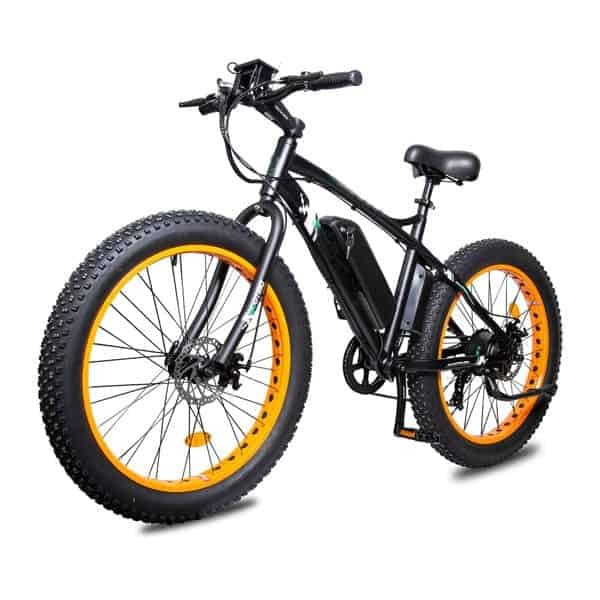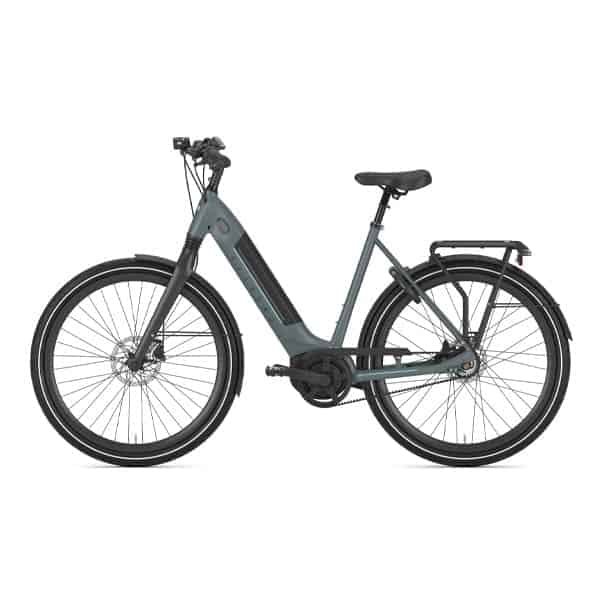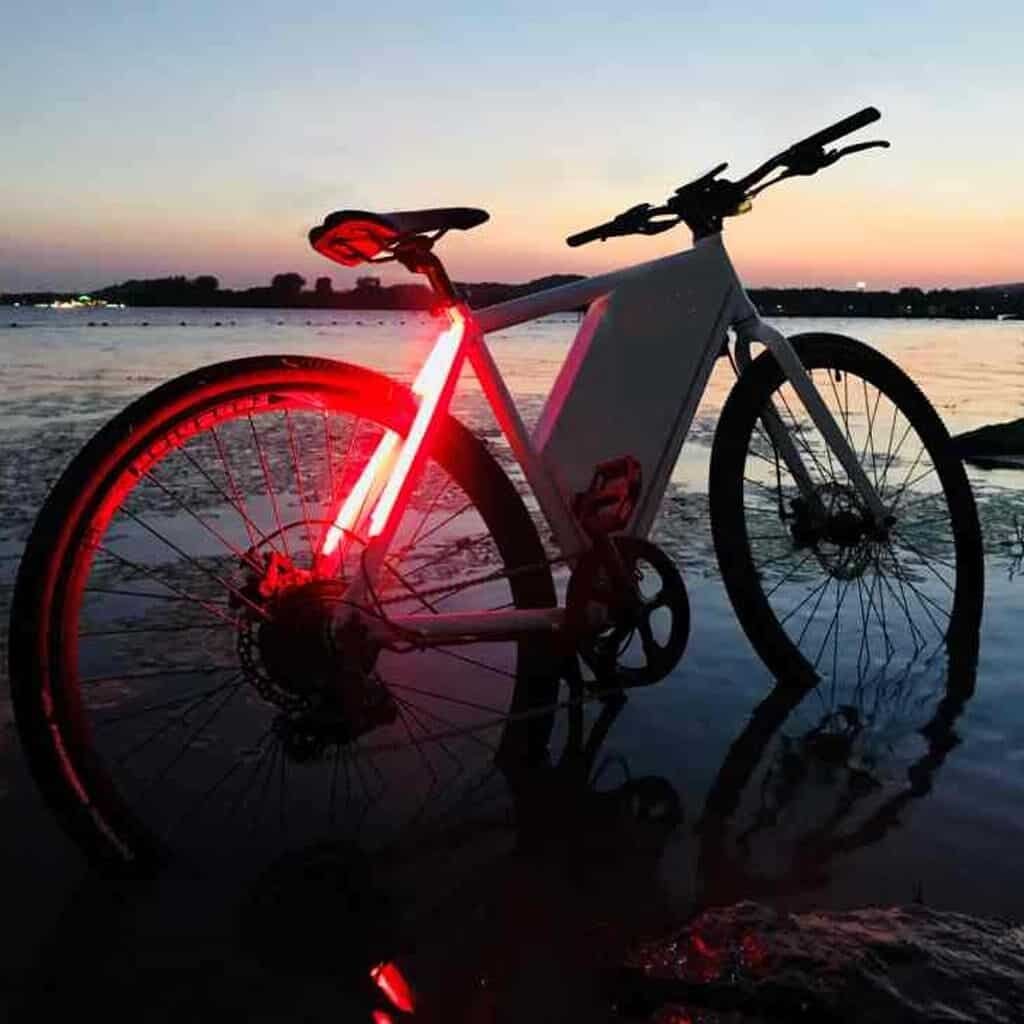Your #1 OEM & ODM eBike Manufacturer
A Complete Guide To Create An Innovative eBike
We Offer OEM & ODM Services As The Leading Electric Bike Manufacturer In China
For many years, the market has demonstrated our current bicycles with their robust, long-ride range characteristics and how well they are put together.
With the rich experience of the ODM project, our ODM customers have been working happily together with us. We have helped many clients create innovative e-bikes during these years, and we are standing on our excellent quality standout e-bikes.
We divided this page into two parts, OEM and ODM of the electric bike.
In the first part, you will get the most popular ebikes in different categories we could make; you could then contact our sales team via any button on this page to get the complete list of our hot-selling ebikes and have them with your logo. You will get a fast response always within 6 hours.
And in the second part, we will be walking you through the whole process of building an innovative e-bike that can make it stand out from its peers. From the frame design to what to consider to choosing the components, you will certainly obtain either the necessary knowledge or inspiration to help you create a unique bike with ease.
We list a table of content for this complete guide, you could click to get into the part you are most interested in directly, but we still suggest reading it sequentially.
OEM E-BIKE
As a leading China e-bike manufacturer, we have a rich experience making lots of popular e-Bikes in different categories.
All the e-bikes in our product list are white labels available for putting your brand name on; that is what we call OEM service.
Check what types of e-bikes we have below and contact us to get the complete product list.
2021 is the largest year of the fat tire e-bike; we are seeing them take off in popularity in recent years. The fat tire e-bike gives people an aggressive and solid feel, which is capable of holding on to more complex terrains.
The fat tires increase their traction dragging across the road and require an excellent brake performance due to their heavier than average weight.
Choose the popular fat tire e-bikes from us and name them with your brand.
The e-bikes in this category are designed with utility and functionality in mind. They are compact, lightweight, and adjustable, making them easy to carry around.
With the large load capacity of rear racks, people can put lots of weight hanging on the back of the bike, and even a child seat is available.
Cheap is considered something being low quality, but that’s not the case with affordable e-bikes from AuroraElectrico.
Folding E-Bike OEM
They are designed for commuters who are short on space, and a suitable fold mechanism helps to fold the bike into a packable size easily and quickly, which is a huge deal for most people who want to carry their bikes around or into transport or upstairs, or put them the back of the car with convenient.
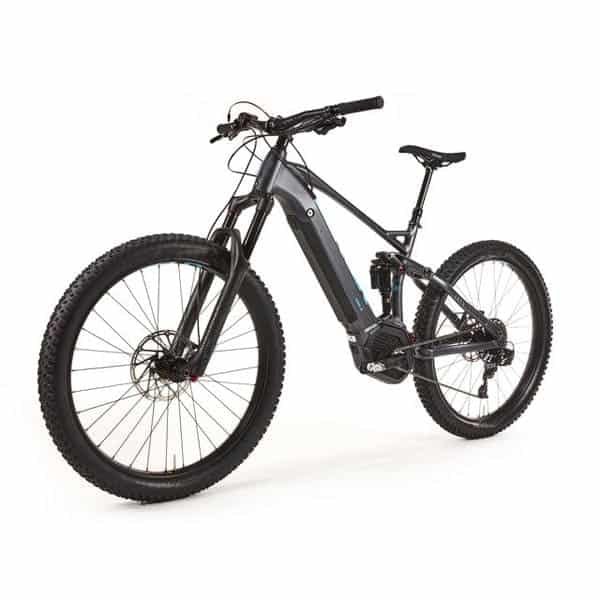
High Performance e-Bike OEM
They are typically powered by a 750W or 1000W rear hub motor and a 720 to 800Wh battery nicely integrated into the frame.
With higher power and higher torque, they are better to overcome the small resistance like the rolling of tires as well as the air resistance to the most popular gravity resistance. They can take the riders to get up to speed quickly and climb hills more easily.
Most of them are equipped with high-performance hydraulic disc brakes, which provide a shorter than average braking distance to ensure safety.

Class 2 and Class 3 eBike OEM
The class 2 e-bike can reach the top speed of 20 miles per hour with the throttle or pedal-assistance, while the class 3 e-bike gets the rate close to 28mph with pedal assist.
Some e-bikes, as we know, are advertised and shipped as class 2 to meet the regulations, but users can easily unlock it to the class 3 ebike in the settings of the display.
At AuroraElectrico, as the leading China eBike manufacturer, we have both e-bikes that perform well with good feedback.

Step-Through eBike OEM
The lower and long tube design of this type of e-bike is accessible and friendly for most short people and tall people with long legs.
All our step-through e-bikes have two tubes connected to the frame, with the upper tube well placed over the lower one instead of removing it, like some others do, to keep the bike stiff and stout.
With adjustable seat posts, people can easily adjust for a comfortable riding position as well as share it with others.
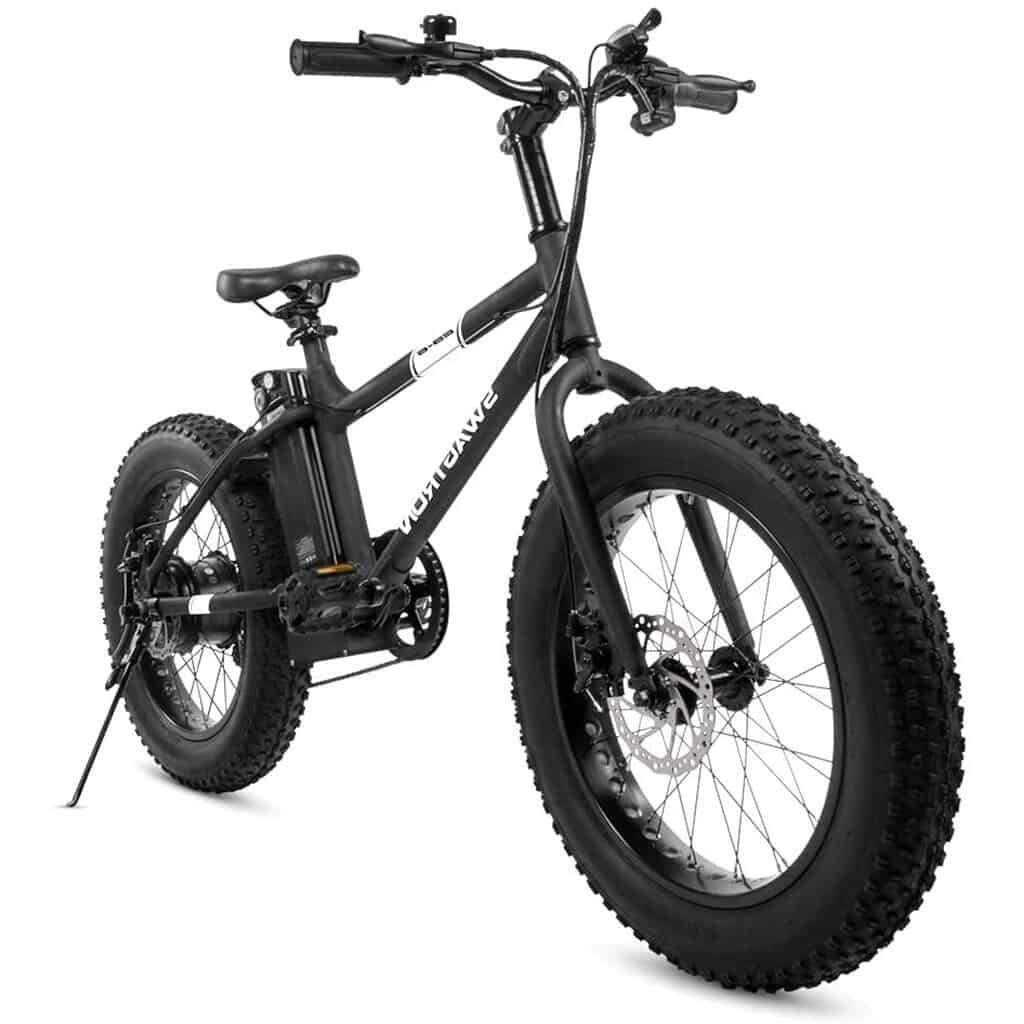
All-Terrian eBike OEM
With a full suspension system with thick forks and powerful mid-drive motors, which take advantage of the bike’s existing gear system to multiply the power at the wheels, these all-terrain e-bikes hold themself well on off-roads by soaking up bumps and obstacles.
More than 4” fat tires with tread increase the traction and grip while doing an excellent job of taking the edge off the bumpy road to provide more comfortable rides.
Click here to see Top Rated E-Bikes Introduction From AuroraElectrico- Keep Updating
How Do We Ensure Good Quality eBikes Produced
Only the quality components are chosen to build bikes.
The strong R&D team with a wealth of experience makes sure the main components in the bike, like the motor, battery, controller, and smart modules, are able to work together in a smooth and compatible way.
Skilled workers with years of experience in assembling bicycles with far fewer mistakes.
The complete quality control system strictly proceeds under careful watching, from the raw materials coming inspection to the riding test before packaging. We own a scientific and systematic process.
Formal certifications for the EU and US markets.
Years warranty promising.
ODM E-BIKE
To create an innovative eBike that can stand out from its peers, you need to do many jobs, including market research, components recognization, Quality function deployment(QDF), benchmarking analysis, brainstorming, customer feedback, SWOT analysis, and more.
As a leading OEM and ODM electric bike manufacturer in China and based on our rich experience in finishing luxury ODM projects globally with particularly great feedback, we would like to share our full steps to build a unique and competitive eBike from a sketch to mass production.
You will certainly acquire an ultimate train of thought to create an innovative e-bike or otherwise at least get some inspiration from this complete guide.
And at last, we will give you some fantastic suggestions in terms of creating an innovative e-bike connecting with the IoT tech, and it could be the highest in gold content in this article, so please read until the end.
Quality Function Deployment
The first important thing we need to do is to find a structured approach to figure out the requirements or demands of your customers and then bring them into the action of the production plan and process, which is what we call the quality function deployment. That is the foundation of creating a whole new e-bike, as customers’ voice is always a critical factor you need to consider in every step of building your brand.
To answer the five questions we often ask our clients when helping them build the bike, and you will clearly define the customer needs, which are then used to set up the matrix for further analysis.
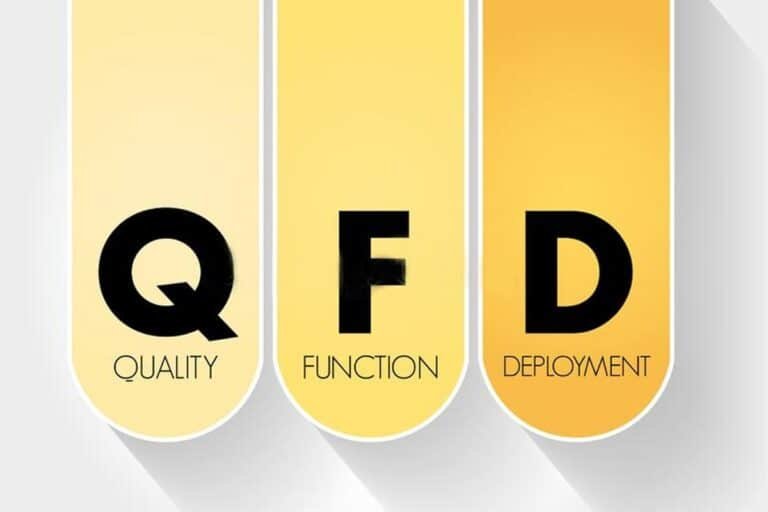
Five Questions
1, What Product Do You Actually Want To Make?
There are many categories in the e-Bike world, from fat tire all-terrain eBikes to foldable small-size commuters, so you want to clarify what kind of bike you are building and consider what features this bike should have accordingly.
You may want a bike that looks just like a standard bicycle with a nicely integrated battery and unnoticeable motor and torquey enough to get up hills with ease, or you may want to equip fat tires with your bike, making them affordable and comfortable. Foldable for space-saving, fast recharging, long-range, safety, ergonomics, customizable, intelligent, lightweight, and many other features you could add to your bike that will finally determine what kind of ebike you create.
There are no best e-bikes for all people, and there only have the best e-bikes for a certain kind of people, which brings us to the next question.
2, Who You Are Going To Sell
Despite eBikes being typically sold to anyone who wants to go faster, further, and carries lots of weight, there are still some significant differences in the specific consumers.
Daily commuters prefer affordable compact e-bikes with a 15-25 miles standard round-trip range as opposed to 30 to 50 miles for saving a large sum of money. At the same time, professionals would like to choose high-end, very expensive fierce eMBT with extreme power and torque for adventuring on heavy off-road.
So what specific users are you targeting? Are you going to sell them to first-time buyers, more gentle riders, or commuters who want to go quickly without too much physical effort, or do you intend to sell them to more aggressive riders with high performance in mind?
3, Why Do Your Prospects Choose Your Product?
People choose e-bikes because they are Eco-friendly and fun to ride. People can get to their office faster with less human effort while keeping fitting. They are good car alternatives for people on their commuting journeys without worrying about the traffic.
But how to make your ebike stand out from the pack?
It depends on how much your item can fit your specific prospects. So we need to give solid reasons for the riders to choose from us.
For example, if you are making an e-bike for daily commuters. Besides some advantages such as: being easy to fold and carry into public transport, lightweight, fast recharging, capable of going uphill, ergonomic design for a more upright body position, and a low price are essential features you need to put on your bike. You may need to add some more advanced functions such as: a percentage-based battery readout to let users know exactly how much further they could go, an integrated headlight that can be controlled via the display, the included front or rear racks for carrying weight needs, fenders options, and a taillight mounted on the side of Seatpost to catch the attention of people around riders for safety reasons, which all of these add-ons will help to increase the competitiveness of a commuter eBike.
4, Where Is Your eBike Going To Be Used?
There are class 1, class 2, and class 3 ebikes on the market, and they differ from where they are allowed to ride on, so be clear of the local laws. We know some ebikes are class 2 when it ships, but users can unlock them to class 3 in the display settings.
Some ebikes thrive on paved back paths and gravel roads, while some others are designed with off-road and more challenging terrains in mind.
Knowing what sort of conditions the e-bike is going to work best will determine what types of suspension and tires should be used.
5, How The Features Come Into The Reality
Now you know what features you want to add to your new ebike, and you will need to know how to make these features come true.
For example, suppose you want the bike to give the rider a smooth power output according to how much effort they put in and the cadence sensor, which will send the pedal power based on how fast it goes. In that case, you may need to bring a more intelligent torque sensor and let users not focus on adjusting their physical effort from time to time to get the best pedal feeling.
What features you want to determine typically determine what kind of components you need to use.
A powerful and torquey motor would be chosen if you need the bike capable of climbing a lot of hills, and a bigger battery is required once you want the cycle to have a more extended range. Still, a big battery will increase the bike’s weight, thus less portability.
In our what-how matrix below, you will know how the components impact the final characteristics of the ebike.
Typical eBike Characteristics
The answers to the above five questions will be used to set up the matrix analysis, which will form the final goal to follow. Still, before getting into the matrix part, we need to list the full characteristics that every type of ebike needs to consider when they are created.
Sleek Design
An appealing design has much to do with increasing the sales volume. People are interested in exploring one bike’s further performance only after its attractive appearance attracts them.
Not only do people need a good eBike, but also an eye-catching one to look at.
Give users more options for different shapes of frames and colors to catch their eyes.
Power & Torque
The unit of watts is used to measure the amount of power the motor will consume when you are using the eBike.
Torque is the force applied to turn the bike forward, which is one of the key factors impacting the climbing ability.
The power is linked to the torque through the following relationship: W = Nm × rpm
There are different types of eBike motors found in the market, and they offer different ranges of power, starting from 35Nm torque and going up to around four times that. Generally speaking, 70-80Nm motors are suitable for steeper climbs, while 30-40Nm can only work well for circulation on relatively flat surfaces.
It is important to know the power range of your eBike motor. It is directly responsible for many performance features like the speed of the eBike, the weight it can carry, and the maximum incline angle.
Range
The range has deeply interconnected with the power; the higher the power you use, the lower the range.
Battery capacity is a key factor in influencing the range but can also increase the total weight.
Other factors like the weight, for wind or against wind, terrains, the steepness of the road, etc. will also impact its range performance.
Good Brake
There are generally two brake systems: rim brakes and disc brakes. Disc brakes are taking over the market because they are more efficient than rim brakes.
Disc brakes have rotors mounted on each hub of the wheel and depend on how the brake force transfers from the lever to the rotor; they have mechanical disc brake and hydraulic this brake
Hydraulic disc brake with the fluid inside, and it referred to when the user pulled the lever. The braking force is generated and compressed via the fluid inside the caliper, which is then moved to squeeze the two opposition braking pads to slow down the rotation of each wheel.
The hydraulic disc brake is much better than the cable-pulling mechanical system in terms of performance and efficiency, reducing a large amount of friction by not having the cable system. And because of their sealed system, hydraulic disc brakes need far less maintenance than the mechanical one, which is an open system, but it is more expensive.
Different types of eBike need different levels brake, so again, your answers to what kind of prospects you are going to target now come into the handy.
Weight
The electric bikes are much heavier than standard bicycles due to the extra motor and matched batteries. The motor and battery provide additional power to make your pedal easy, but the added weight will increase the difficulty of use.
Weight reduction nowadays is an important goal that many e-bike manufacturers have been pursuing. Strong yet lightweight materials like Al alloy, magnesium alloy, and carbon fiber are widely used to make the frame.
However, design is the biggest factor that impacts the bike’s weight. If you are trying to create a bike with strong and capable of climbing steep hills, in addition to a powerful torque motor, you also need a bigger battery to support that big consumption. So this climbing bike will be heavier than normal even with the frame made of lightweight materials.
Weight is always a trade-off. In the example above, you are trade-off the portability for the high climbing performance.
Safety
Electric bikes go at a much higher speed than the standard bicycle thus, an extremely brake performance is completely necessary for safety reasons.
Turn lights, reflective fat tires with good grip, a loud bell, hydraulic disc brake, stable handlebars, and bright taillights are all safety features you could consider adding to your bike
Portability
Not only do people consider the situation when they ride the bike when purchasing an ebike, but also they do think when they don’t ride it.
So a compact, easy to store and carry is an ideal choice for anyone who lacks space.
Regarding the portability, you may want your bike features like these below:
A foldable ebike can be easily thrown into the back of a car
An ebike can be packed down to a packable size to be easily put under the desk or lean against the wall
A lightweight eBike made of aerospace-grade aluminum makes it carry up the stairs or into the public transport with ease
A small ebike can stand on its rear rack when folded, which is a cool feature for anyone short on space
Comfort
To make the eBike more comfortable, there are two aspects you could do: ergonomic design to consider and quality components to choose from.
Ergonomic Design
Wide and supportive comfortable saddle for not having numbness
Ergonomic and decently wide handlebar for a better and natural grip on long rides without being tired
Rubber grips, instead of leather, offer a not-sticky feel when the palms get slick
The ergonomic design frame for a more upright body position or the old Dutch position is the best sitting position for comfortable riding.
Step-thru frames for easy access are suited for short people and others who have long legs
Height adjustable saddle and handlebars
Comfort Components
Thick suspension fork for better smoothing out the bumps and handling well on gravel and light off-road
Chosen fat tires with studded and tread on them to provide better traction and keep the bike stable when it gets up to speed
Solid construction to reduce the noise at a high speed
Pedals made of alloy to offer a stiff pedaling platform
Low Price
Price is always a huge factor impacting the final buying decision.
Weigh the importance of each component which takes up costs based on what kind of the ebike you are making and what specific users you are targeting. Enlarge the features your customers may watch for the most and give up the opposition to give users the ebike best suited to their needs at the very lowest price.
That is also the ultimate purpose this guide wants to reach.
Easy to Use
It includes a simple display showing a clear readout of the current speed and how many batteries have left and a simple and easy-to-use foldable mechanism that doesn’t need a manual to operate.
Fast to Charge
Support quick charge and not the big capacity in ampere-hours is necessary for a fast recharge.
The fast charge can compensate for not having a big capacity battery, which adds weight to decrease the ease of use.
Matrix
There are three matrices in this part that need to be set up for analysis to get a clear direction for building the bike
Independence (Dependence) Matrix
Each ebike characteristic, as we mentioned above, is interconnected. No completely independent characteristic can be a function of the entire ebike system.
Here we need to set up a matrix to know which characteristics are the most dependent on others clearly, so pay more attention to them in the entire designing process
We separately list all characteristics in the rows and columns in the matrix. And we value 0, 2, and 3 for expressing the degree of dependence of characteristics in the rows to the ones in the columns.
To make the result as accurate as possible, you may have to do further market research and invite as many of your employees and engineers. Customers as possible to participate in this questionnaire.
We would like to share a representative independence matrix picked out from many of our projects for reference:

As we can see from the table matrix, price is the characteristic that depends on others the most, and the following characteristics are weight, portability, and range.
Thus, we need to consider price, weight, and portability every time we want to change even a little for other variables.
Importance Matrix
The importance matrix will help us understand the more critical features customers would watch for when to purchase, which we should focus on.
We list all representations in rows and columns and use the numbers -1, 0, and 1 to value the importance.
If the characteristic in the row is less important for customers than the one in the columns, use -1. Otherwise, use 1. And 0 refers to when they have the same importance.
Below is an example of an importance matrix for commuter bikes. Please note the result of importance features to customers can vary greatly for different kinds of eBikes.

We can rank the importance of these attributes based on the below table: Sleek design=Big power and torque>Low Price>Portability>Lightweight>Comfort>Safety>Good Brake>Long Range=Fast to Charge>Easy to Use
The importance matrix does a lot job of helping us focus on the critical attributes that are worth the investment of energy and money
What-How Matrix
We already have the importance matrix, so we know what attributes should have on what we are creating, but how to make them come true? What-how matrix will do the job.
We list the important attributes that customers may watch for in the columns and the technical charectrics in the row. A value from 0 to 3 according to how much each one in the row can satisfy the one in the column.
As we can see from the below table, if we want to create a commuting ebike which was often ridden on a city environment, you would likely need to focus on motor types, battery capacity, frame, and tire types when designing and building.

To create an innovative eBike, competitor analytics is essential; we need to compare the advantages and features of different eBikes from different brands, and the results will help us to upgrade our existing products, making them more attractive.
We list the main attributes of an eBike from various manufacturers and look at the best value of each characteristic.
We pick the best value of each attribute among all these brands and put them at the end of the column to create an ‘ideal eBike’ made of the best value for each row. It’s impossible to have an eBike with features entirely better than every one listed in the ‘ideal eBike’ column, but we need to make it with at least two technical features better than that.
There are three rows at the bottom showing the numbers of this manufacturer’s best and worst values compared to others. Starting with the best value minus the worst, we get a sum indicating how much it outperforms others. The more score a brand receives, the more advantages it has.

Design System

We know now what kind of eBikes we want to create, and next, we need to understand how to make it come true in detail, so this part is an expansion of What-How matrix mentioned above.
We will discuss what parts are made up of a complete eBike system and how different types of components can affect the performance of an eBike. As a leading electric bike manufacturer, we are able to provide all the options we mentioned in this guide for each component for customization.
So not only could you get the knowledge of the pros and cons of each type of component and pick up and combine these available components that you prefer direct from us.
An electric bike is a mechanical and electrical combination system that includes the frame, braking system, steering system, human-driven system, and electric-drive system.
Every eBike, before they are born, will need specific performance requirements according to what types they are going to be made. The requirements include braking distance, the capability of holding on rugged terrains, acceleration capability, maximum speed, climbing hill ability, power transfer efficiency, and more.
And it requires specific characteristics as well, like how long you want it to last on a single charge, how light you want it to be, ease of transportation, practicality to fold, safety, etc.
E-Drive System
E-drive system is probably the most critical part inside the electric bike that makes it different from the standard bicycles.
The electric drive system consists of the motor, battery, controller, various sensors, and display.
Motor
To choose a suitable motor, below basic information need to be clear first.
Two Different Types
There are many kinds of motors on the market, and the two most popular ones are hub-drive motors and mid-drive motors.
Hub-drive motors are mounted on either the front or rear hub of a wheel, which is cheaper and less efficient than the mid-drive motor that is positioned in the center of the ebike, taking advantage of the bike’s already existing gears.
Power Ranting Is Not Equal To How Power An eBike Performs
It is generally accepted that the more power rating manufacturers claim, the more powerful an eBike feels. However, the nominal power is just a small factor in determining how powerful a bike is, it depends on the configuration of the eBike. That is because the amount of wattage rating from the motor is not the same as the one at the wheels.
A good example of the difference between the motor power rating and how actual powerful an eBike performs could be found when you compare the hub-drive motor and the mid-drive motor.
Because the mid-drive motor can amplify the energy through the bike’s gears, the force of turning the wheels rotating is greater than the force put in; thus it supplies a better amount of power to the wheels.
That’s why we could often see in some cases that a 500W or even 750W bigger wattage rating eBike has less power than the one with smaller 350W wattage.
Continuous Power And Peak Power
Another factor that makes the power confusing for many people is the misunderstanding of the rate of the power
The motor produces the energy needed to make the eBike forward, and typically there are two types of power we usually see: continuous power and peak power. The constant power means the maximum power the motor can hold or consume without overheating. The peak power refers to the max power the motor can manage in a very short amount of time by increasing the current via the adjustment of the controller.
The peak power is useful only in extreme situations, such as climbing a very steep hill or similar. Typically, the nominal power that most manufacturers claim is continuous power. However, some manufacturers put a peak power rating in their spec sheet to blur the conception letting users under a misapprehension.
However, the situation may be just the opposite in many cases, many manufacturers only tell users their motors are 250W, 500W, or 750W. You don’t know where their limits are, which could have a much bigger peak power such as 1500W or 2000W, that is because of the regulation in EU and US to take the limit of the maximum power very low.
Cadence Sensor And Torque Sensor
To choose the suitable motor that can work best with your eBike, besides considering its types and power rating, what sensors to add should be also under the consideration.
Generally, there are two typical sensors when it comes to the motor, the cadence sensor and the torque sensor.
The cadence sensor monitors the bike’s movement and how fast it goes to tell the motor to turn and off, while the torque sensor can know how hard you force the pedal and send the assist power accordingly. Some ebikes only have cadence sensors, especially for cheaper ones, but torque sensors can give a more natural pedal feel to the riders who even without realizing the interaction between their effort and the electric system.
What To Consider When Choosing A Motor?
The application of the eBike is the most important thing to take into account when choose a motor, a bicycle designed for urban city will differ greatly in motor choosing than a bike with heavy off-road use in mind.
8 factors to determine your decision
Choosing 8 certain type of a motor will certainly influence other characteristics of the eBike, as we mentioned above in the independece part.
We list 8 usual factors that may affect the bike’s final performance that you need to take into account when choosing the most suitable motor. And you could weigh them from 1 to 5 depending on your specific demands, 1 is the least important and 5 is the most important factors to affect your decision.
1- Weight
Motor and battery contribute a lot to a heavy eBike, so choose the correct size of the motor according to whether you need to take the lightweight as the biggest selling point of your eBike. If you are creating a portable folding compact eBike for people who need to carry them around often, then the weight will be marked 5 as one of the most important factors you want to consider.
2- Weight distribution
The eBike with mid-drive motor often owns low center of gravity because of it’s position compared to the hub-drive motor, which is helpful for the handling characteristics of the eBike.
Hub-drive motor, depends on where they are mounted, will give riders either a feel of push or pull. Thus it may need riders take some times to adapt, while mid-drive ones keep the bicycle simple that can be operated almost the same way as a traditional bike.
3- Performance
The power is the rate of the job to be done, the bigger wattage motor can produce more power at a certain time or produce the same power in a less time. And torque is the turning force aganist resistences like gravity when climbing hills.
So higher wattage and higher toque equal to the strong acceleration ability and capable of climbing hills.
Mid-drive motor is better than hub-drive motor in terms of torque, that is why we could see they are the standard part on most eMTBs.
4- Wear and tear
The hub motors require the maintenance less frequency and can cause wear and tear by not having the open moving parts, like the crank, chainrings and chain, which the mid-drive motor does.
5- Ability when uphill
Many eBikes with hub motor is likely to struggle or even come to a stop in the steep sections around 12 to 15 degrees at throttle-only modes or level 1 pedal assit with less human effort.
6- Unnoticeable
Many eBikes with hub motors and standard bicycles are so alike because they are nicely intergrated into the center of a wheel.
If your popuse is going to build a sleek eBike with unnoticeable motor which looks very closed to the traditional one, weigh the high number on hub motor for its aesthetics
7- Easy to replace
The hub motor is easier to be mounted and removed than the mid-drive one, which require more work and a proper frame design to adapt its shape
8- Price
Powerful motor always need a high cost and requires a bigger battery to match, which will increase the a further cost.
And mid-drive motor is generally expensive than hub-drive motor.
What We Could Offer
The leading gloable motor manufacturer are Yamaha, Bosch, Dapu, Lishui, Ananda, and Bafang.
Here in AuroraElectrico, we supply a wide range of motors branded or non-branded for you to choose. We can suggest a suitable motor for your specific project while accepting any motor appointed.
Battery
Choosing a battery size depends on what kinds of eBike you are making because more power and capacity result in more weight.
Besides that, you need to think of whether the battery can be removable and where to place it. Is it easy to mount and remove for charging?
As a considerable heavy component, the battery impacts a lot on the mass center of an eBike, which, in turn, influences the handling performance.
Controller
The controller regulates the current flow from the battery to the motor, making the motor under controllable.
It’s mounted inside of an e-bike connecting and putting all key components together, like motor, battery, paddle assistant, LCD display, sensors, and throttle, to control the motor’s speed, start, and stop.
If you want to use the right controller with your electric bike, you need to consider several factors.
First, you need to check whether the controller voltage and power are the same as those of the motor when selecting because overheating is a likely consequence of running too much voltage through a controller.
It would be best to consider the controller type to match the current motor type used on your e-bike.
There are brushless, sensored, sine wave, and s and square wave controllers.
Human-Drive System
Drive Chains
The main suppliers of drive chains: Shimano, Sram, Lunfeng, KMC, Sunrace, Prowheel, Gate, Formula, Quando, FSA.
Single speed, multi-speed and internal gearing system
We often see the single-speed system on affordable electric bikes, and they actually can work very well until when going steep hills.
The internal gearing system allows the gear ratio change even when the bike doesn’t move. That makes sense when you stop at a stop light, in order not to have a hard time restarting in high gear, you don’t have to shift gears down before stopping. It is a big advantage of the internal gearing system compared to the multi-speed ones.
Another feature for the internal gearing system is it doesn’t need frequent maintenance because its mechanism is all inside the wheel hub, which makes it being ahead of the aesthetics.
Tires
You could pick out from the fat tires, semi-slick tires, and regular tires.
Fat tires are great for comfortable riding on off-road. However, many people are becoming big fans of semi-slick tires nowadays, which are pavement-oriented while still providing enough traction to drag across any less accessible terrains. And they are typically not as heavy as the fat tires that require a larger need of energy consumption.
Small size tires are great for reducing the volume occupied, which is a good choice for anyone short on space.
Steering System
It includes the handlebar and stem.
Leading suppliers of a steering system: Tranzx, Syntace, Zoom.
To choose the right steering system working well with the eBike, you need to consider several specifications such as the materials, width and diameter of the stem, and heat treatment.
The choice of the steering system related to the handling characteristic
Brake System
Main suppliers of brake: Shimano, Tektro, Magura, Sram
The premium hydraulic disc brakes are always equipped to more aggressive e-bikes with heavy weight and a high top speed. Besides that, the road conditions, brake ability you need, and type of chosen motor are all factors to affect the type of brake you want to pick.
Suspension
The common types of suspension systems are rigid suspension, spring, air spring, and hydraulic suspension.
The wheel diameter, tire width, and riding conditions are the main factors in determining which type of suspension is going to be used.
The leading suppliers are SR Suntour, RST, RockShox, and Fox
You could use a front fork suspension or a rear fork, or both for your e-bike. The front shock connects the wheels, frames, and handlebars to provide a more front part suspension, while the rear one is primary for the rear wheel.
Frame
Based on the Quality Function Deployment, we know that the frame is the key to success. The structure should be designed with simple, beautiful, and proper distributed weight in mind.
In addition to its design, the frame must be capable of holding enough rider’s weight and cargos. That is why we have to do the load test to simulate different riding conditions, making sure the frame designed is functional enough for use.
The frame design is one of the most complex processes, including CAD application, style choice, ergonomic design, materials, surface treatment, and colors.
Electric bike frame styles
We’ve divided the standard frames into approximately 3 styles: natural, retro, and advanced. See below for reference.

Ergonomic Design
Over 80% of riders suffer from pain at long-distance riding on their neck, arms, and back, so an ergonomic frame design that provides a more upright position for comfortable long rides is undoubtedly necessary.
A classic example of a great ergonomic design is the old dutch e-bike, it can support our natural S-shape of the spine, and people only need half of their effort to bend over their body to catch the handlebar.
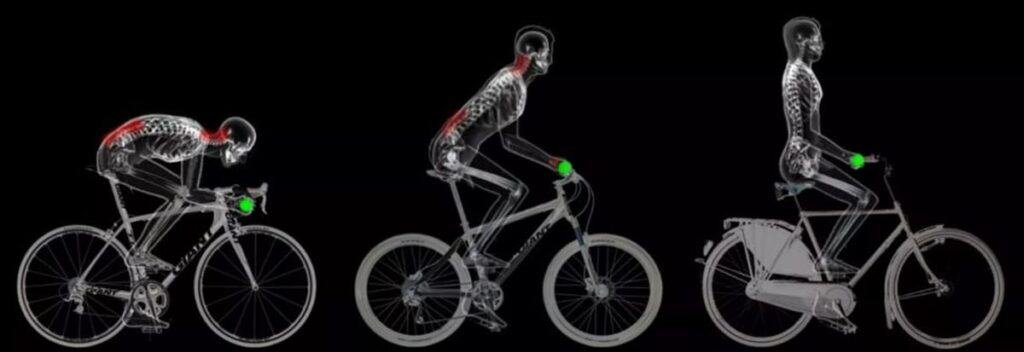
And the large diameter tires or other parts of an e-bike may require an extended or higher, or longer frame, which would need the rider’s head and neck bending at a tighter angle, causing pain.
Load Cases
We may have to simulate at least three cases to get realiable results.
The first load case would show a situation where a rider is sitting on the saddle, so a vertical load of 2500N should be pressed on the center of the frame.
And the forces both on the seat, handlebar, and the bottom brackets should be applied to simulate the second situation of when the rider sits on the saddle, gripping the handlebar, and pedaling.
Another scenario often happens when climbing hills where the rider stands on the foot rest and shifts their center-of-gravity left or right to pedal the plate. So the oblique forces on the saddle, handlebars and the pedal plate should be put on the frame.

INNOVATION
Never sell the market similar e-bikes to compete with others using a low price, but create an innovative bike with a unique charming design and practical features, such as connecting the bike to the internet.
This part is probably the highest in gold content in this guide; we will give some really excellent innovative suggestions connected with the current trend of IoT technology to make your eBike stand out from others.
And most importantly, we are not only providing suggestions. With many years of ODM experience and a strong R&D team in terms of IoT tech, we can also make these recommendations come into reality!
SOS Message Sending System For Safe
A detectable crash system could be added to the bike to send SOS messages if any emergency happens.
With intelligent fall sensors inside the system, an SOS message could be sent immediately to the emergency numbers, which the user authorizes via the connected phone app.
To not cause unnecessary confusion by sending a wrong message, we need to give users a little bit of time, like one minute, to identify and cancel the sending message unnecessarily on the display when the fall sensor detective something unusual. Suppose there is no interaction after the given time. In that case, the message could be sent, with the accurate position thanks to the GPS model inside, to the nearest hospital as well as the nearby community members. They have joined the rescue league organized by the e-Bike manufacturer.

IoT Makes The eBike Smart And Connected
IoT module could help track maintenance on most critical components such as the motor, the battery, controller, and tires. The system contains the maintenance record, components issue reminders, next maintenance time, etc.
GPS Module Makes The eBike Connected And Safety
The manufacturers could easily set up an inter-communication network consisting of users or fans via GPS, which is something absent in the current eBike market.
And it will do a great job of keeping the e-bike safe by connecting GPS to the remote bicycle lock. Users can lock their not cheap eBike via an app on their phone and know where the bike is, even indoors. It is an efficient way to be away from the stolen, making their hard-earned money safe.
Connecting the eBike to the internet is not the exclusive technology for the shared bike market; a few big brands are trying to add IoT features to their oncoming e-bikes for the individual market.
Final Thoughts
Creating an innovative e-bike that sets them apart from most others in the market is not an easy thing to do. Knowing what type of e-bike you are going to build, what specific users you are targeting, and where they will be grinding on are just a few steps of this thousand miles journey.
A sleek appearance with the suitable material chosen to build a stiff enough but not too heavy frame is obviously a challenge for every designer.
In addition, you are facing a ton of questions like what types and sizes of the motor and battery to choose, and where to position them, what kinds of the brake system you need to use to reach the ideal performance, how to choose the right size and type of tires and suspension systems to make the bike comfort, and would it actually necessary to make the bike that comfort?
All these detailed questions come up together, making the whole process more complicated. Thus we need a scientific way to get your idea into shape, and that is what we’ve introduced in this article.
Going along the method of the Quality Function Deployment to set the key points ahead of you to help to create an innovative eBike and, most importantly, find out a reliable manufacturer with rich e-bike ODM experience to work with, like us, AuroraElectrico, who will give you valuable recommendations during the whole process and save your time.

